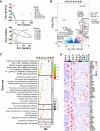Sequential Exposure to IL21 and IL15 During Human Natural Killer Cell Expansion Optimizes Yield and Function
- PMID: 37649085
- PMCID: PMC10618651
- DOI: 10.1158/2326-6066.CIR-23-0151
Sequential Exposure to IL21 and IL15 During Human Natural Killer Cell Expansion Optimizes Yield and Function
Abstract
Natural killer (NK) cells are frequently expanded for the clinic using irradiated, engineered K562 feeder cells expressing a core transgene set of membrane-bound (mb) IL15 and/or mbIL21 together with 41BBL. Prior comparisons of mbIL15 to mbIL21 for NK expansion lack comparisons of key attributes of the resulting NK cells, including their high-dimensional phenotype, polyfunctionality, the breadth and potency of cytotoxicity, cellular metabolism, and activity in xenograft tumor models. Moreover, despite multiple rounds of K562 stimulation, studies of sequential use of mbIL15- and mbIL21-based feeder cells are absent. We addressed these gaps and found that using mbIL15- versus mbIL21-based feeder cells drove distinct phenotypic and functional profiles. Feeder cells expressing mbIL15 alone drove superior functionality by nearly all measures, whereas those expressing mbIL21 alone drove superior yield. In combination, most attributes resembled those imparted by mbIL21, whereas in sequence, NK yield approximated that imparted by the first cytokine, and the phenotype, transcriptome, and function resembled that driven by the second cytokine, highlighting the plasticity of NK cell differentiation. The sequence mbIL21 followed by mbIL15 was advantageous in achieving significant yields of highly functional NK cells that demonstrated equivalent in vivo activity to those expanded by mbIL15 alone in two of three xenograft models. Our findings define the impact of mbIL15 versus mbIL21 during NK expansion and reveal a previously underappreciated tradeoff between NK yield and function for which sequential use of mbIL21-based followed by mbIL15-based feeder cells may be the optimal approach in many settings.
©2023 The Authors; Published by the American Association for Cancer Research.
Figures






Similar articles
-
Membrane-bound IL-21 promotes sustained ex vivo proliferation of human natural killer cells.PLoS One. 2012;7(1):e30264. doi: 10.1371/journal.pone.0030264. Epub 2012 Jan 18. PLoS One. 2012. PMID: 22279576 Free PMC article.
-
Autonomous growth and increased cytotoxicity of natural killer cells expressing membrane-bound interleukin-15.Blood. 2014 Aug 14;124(7):1081-8. doi: 10.1182/blood-2014-02-556837. Epub 2014 Jul 8. Blood. 2014. PMID: 25006133
-
Phenotypic and functional characterisation of locally produced natural killer cells ex vivo expanded with the K562-41BBL-mbIL21 cell line.Clin Exp Med. 2023 Oct;23(6):2551-2560. doi: 10.1007/s10238-022-00974-2. Epub 2022 Dec 17. Clin Exp Med. 2023. PMID: 36527513
-
Feeder Cells at the Interface of Natural Killer Cell Activation, Expansion and Gene Editing.Front Immunol. 2022 Feb 11;13:802906. doi: 10.3389/fimmu.2022.802906. eCollection 2022. Front Immunol. 2022. PMID: 35222382 Free PMC article. Review.
-
Ex vivo expansion of natural killer cells for hematological cancer immunotherapy: a systematic review and meta-analysis.Clin Exp Med. 2023 Oct;23(6):2503-2533. doi: 10.1007/s10238-022-00923-z. Epub 2022 Nov 4. Clin Exp Med. 2023. PMID: 36333526
Cited by
-
Cytokines in Focus: IL-2 and IL-15 in NK Adoptive Cell Cancer Immunotherapy.Immune Netw. 2025 Apr 9;25(2):e17. doi: 10.4110/in.2025.25.e17. eCollection 2025 Apr. Immune Netw. 2025. PMID: 40342841 Free PMC article. Review.
-
Integrated ATAC-seq and RNA-seq analysis identifies key regulatory elements in NK cells activated with feeder cells and IL-2.Bioeng Transl Med. 2025 Feb 26;10(3):e10747. doi: 10.1002/btm2.10747. eCollection 2025 May. Bioeng Transl Med. 2025. PMID: 40385536 Free PMC article.
-
Secretome and Cellular Composition of Peripheral Blood Mononuclear Cells Cultured in the Presence of Cell Feeder or Interleukins.Bull Exp Biol Med. 2025 May;179(1):147-153. doi: 10.1007/s10517-025-06449-0. Epub 2025 Jul 19. Bull Exp Biol Med. 2025. PMID: 40682655
-
Interleukin-21 engineering enhances CD19-specific CAR-NK cell activity against B-cell lymphoma via enriched metabolic pathways.Exp Hematol Oncol. 2025 Apr 2;14(1):51. doi: 10.1186/s40164-025-00639-2. Exp Hematol Oncol. 2025. PMID: 40176196 Free PMC article.
-
Chimeric antigen receptor-natural killer cell therapy: current advancements and strategies to overcome challenges.Front Immunol. 2024 Apr 25;15:1384039. doi: 10.3389/fimmu.2024.1384039. eCollection 2024. Front Immunol. 2024. PMID: 38726000 Free PMC article. Review.
References
-
- Kirchhammer N, Trefny MP, Natoli M, Brücher D, Smith SN, Werner F, et al. . NK cells with tissue-resident traits shape response to immunotherapy by inducing adaptive antitumor immunity. Sci Transl Med 2022;14:eabm9043. - PubMed
-
- Robertson MJ, Ritz J. Biology and clinical relevance of human natural killer cells. Blood 1990;76:2421–38. - PubMed
Publication types
MeSH terms
Substances
Grants and funding
LinkOut - more resources
Full Text Sources
Other Literature Sources
Miscellaneous

